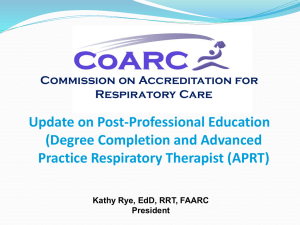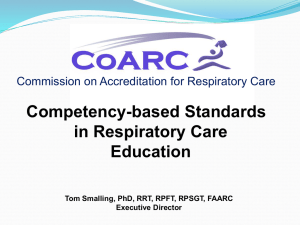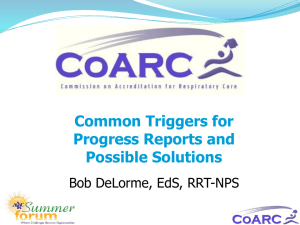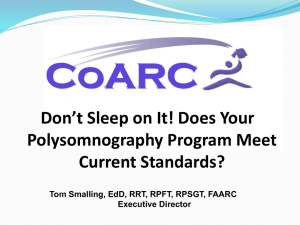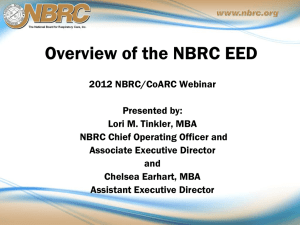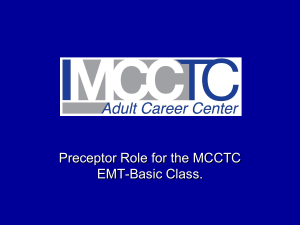What Every New DCE Needs to Know
advertisement
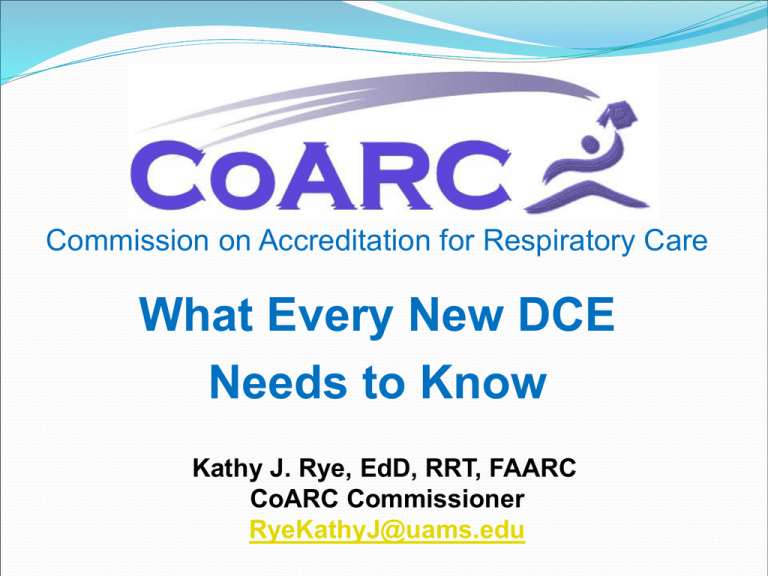
Commission on Accreditation for Respiratory Care What Every New DCE Needs to Know Kathy J. Rye, EdD, RRT, FAARC CoARC Commissioner RyeKathyJ@uams.edu Objectives This presentation will cover issues relevant to the position of Director of Clinical Education (DCE) with an emphasis on meeting accreditation requirements. Job Responsibilities; Management & Administration; Continuous Review & Analysis; Planning & Development; Questions & Answers. www.coarc.com www.coarc.com Job Description Provide clinical direction of program fulfilling the requirements for accreditation. Assist with program planning & curriculum development. Provide didactic, laboratory, &/or clinical instruction. Develop cognitive, psychomotor, & behavioral objectives for clinical practice performance. Communicate expectations to students / clinical instructors about the clinical component of program. www.coarc.com Job Description Evaluate student performance. Develop / support program policies and procedures. Accept committee assignments. Assist with recruitment of qualified students/faculty. Serve as an academic advisor for students. Act as a professional role model. Maintain your own expertise and competency through continuing education. www.coarc.com www.coarc.com Familiarize Yourself With the Standards Definitions – the use of a definitions list provides clarification of key terms. Evidence of Compliance- Below each Standard to clarify the requirements for compliance with each Standard. www.coarc.com Purpose of Standards Outlines the minimum requirements to which an accredited respiratory care program is accountable. Used for the development, evaluation, and selfanalysis of respiratory care programs. www.coarc.com Evidence of Compliance Facilitates the program’s response to progress reports and accreditation actions by CoARC, development of self-study reports, and site visit preparation / review. Each item of evidence represents the minimal information necessary to determine compliance. Each item must be addressed. Additional information that the program believes supports compliance may also be provided. www.coarc.com Standard II – Institutional and Personnel Resources Institutional Resources Personnel Resources Key Program Personnel Program Director Director of Clinical Education Medical Director Instructional Faculty Administrative and Support Staff www.coarc.com Standard II – Institutional and Personnel Resources 2.09 The DCE must be responsible for organization, administration, continuous review, planning, development, and general effectiveness of clinical experiences for students enrolled in the respiratory care program. Teaching & administrative workload schedule; Institutional job description. www.coarc.com Standard II – Institutional and Personnel Resources 2.10 The DCE must hold a valid RRT credential and hold such professional license or certificate as is required by the state in which he or she is employed. State license and RRT verification by the NBRC. www.coarc.com Standard II – Institutional and Personnel Resources 2.11 The DCE must have earned a least a baccalaureate degree from an academic institution accredited by a regional or national accrediting agency that is recognized by the USDE. Academic transcript denoting the degree earned. www.coarc.com Standard II – Institutional and Personnel Resources 2.12 The DCE must have a minimum of 4 years of experience as a RRT; of which at least 2 years must include clinical respiratory care. The DCE must have a minimum of 2 years experience teaching in an accredited RC program either as an appointed faculty member or as a clinical preceptor. Personnel records, including a curriculum vitae. www.coarc.com Standard II – Institutional and Personnel Resources 2.13 The DCE must have regular and consistent contact with students, faculty, and clinical affiliates regardless of program location. Results of student course evaluations. www.coarc.com Standard II – Institutional and Personnel Resources 2.15 …there must be sufficient faculty to provide effective instruction in the didactic, laboratory, and clinical setting. In clinical rotations, the student to faculty ratio cannot exceed 6 : 1. Results of annual program resource assessment as documented in the CoARC RAM; Institutional student surveys of instruction (e.g., course evaluation). Course class lists and faculty teaching schedules. www.coarc.com Standard III – Program Goals, Outcomes, and Assessment Statement of Program Goals Assessment of Program Goals Assessment of Program Resources Student Evaluation Assessment of Program Outcomes Reporting Program Outcomes Clinical Site Evaluation www.coarc.com Standard III – Program Goals, Outcomes, and Assessment 3.11 The program must develop processes that facilitate the development of inter-rater reliability among those individuals who perform student clinical evaluations. Records of training participation by clinical evaluators; Results of a review of student evaluations for the purpose of determining inter-rater reliability. www.coarc.com Standard III – Program Goals, Outcomes, and Assessment 3.16 The program must define and maintain consistent processes for the initial and ongoing evaluation of all sites and preceptors used for students’ clinical practice experiences. The program must apply comparable evaluation processes to all clinical sites regardless of geographic location. Program evaluation plan with results for all clinical sites and preceptors; Student evaluation of all clinical courses, sites and preceptors; Student and program personnel resource assessment surveys. www.coarc.com Standard IV– Curriculum Minimum Course Content Minimum Competencies Length of Study Equivalency Clinical Practice www.coarc.com Standard IV– Curriculum Minimum Competencies 4.09 Problem solving strategies in the patient care setting. Develop clinical course mechanism to evaluate the student’s ability to apply knowledge, perform appropriate patient care, solve problems, and demonstrate appropriate behavior. www.coarc.com Standard IV– Curriculum Equivalency 4.11 The program must ensure that…. learning experiences (didactic, laboratory, and clinical), and access to learning materials are substantially equivalent for each student regardless of location. Sufficient breadth and depth of clinical exposure to ensure achievement of clinical competencies. www.coarc.com Standard IV– Curriculum Clinical Practice 4.12 The program must document that clinical education experiences at each clinical site are of sufficient quality and duration to enable students to meet program goals and acquire the competencies needed for clinical practice. www.coarc.com Standard IV– Curriculum 4.12 Clinical Practice (Evidence of Compliance) Clinical evaluation mechanisms that document the progressive independence of the student in the clinical setting; Clinical syllabi detailing student competencies; CoARC graduate and employer surveys; Program evaluation plan and results for all clinical sites and preceptors; Results of student clinical course, site, and preceptor evaluations; www.coarc.com Standard V– Fair Practices and Recordkeeping Disclosure Non-discriminatory Practice Safeguards Academic Guidance Student Identification Student Records Program Records www.coarc.com Standard V– Fair Practices and Recordkeeping 5.09 Non-discriminatory Practice Students must NOT secure their own clinical sites and preceptors. Keep detailed clinical schedules. www.coarc.com Standard V– Fair Practices and Recordkeeping 5.11, 5.12, 5.13 Safeguards Develop clinical policies with regard to the health and safety of patients, students, & clinical faculty / preceptors. Ensure that students not used for clinical, instructional or administrative staff. Ensure that no clinical coursework completed while an employee at a clinical site www.coarc.com Standard V– Fair Practices and Recordkeeping 5.15 Academic Guidance Clinical policies & procedures for students. Documented HIPAA training. 5.17 Student Identification Policies governing clear identification in all clinical settings (wearing badges, personal interaction, and introduction). www.coarc.com Standard V– Fair Practices and Recordkeeping Student Records & Program Records Maintain all records of clinical advisement, counseling and evaluation; Maintain records of any clinical remediation and/or disciplinary action. Maintain clinical syllabi, clinical affiliation agreements, and clinical schedules. Must maintain records on file for 5 years (electronic or hard copy). www.coarc.com www.coarc.com What they shared with me: “The first thing a new DCE needs is a mentor, followed by a box of Kleenex and a big stick (for postural support of course)!” www.coarc.com A new DCE’s advice: “Buckle your seat belt and keep your arms inside the yellow lines at all times. Get organized. You won’t survive if you don’t.” “Don’t reinvent the wheel, use a program like DataARC or develop your own. You don’t have to drown in paper work. But, you are going swimming.” www.coarc.com Additional responsibilities – what a shocking realization….. “Patients first then everything else (profession, students, school, department, hospital, etc..) but I didn’t realize I was about to become an educator for my affiliate preceptors. ” www.coarc.com Additional responsibilities – what a shocking realization….. “I guess I was naïve – thinking that all preceptors are created equal and that all RTs are capable of effective communication.” “I discovered preceptors’ needs are really the same as students. They need feedback, reassurance, instructions, help and understanding.” www.coarc.com Additional responsibilities – what a shocking realization….. “The responsibility of maintaining a team of educators at over 10-15 active clinical sites at a time is a challenge I didn’t expect.” “I think I was naïve – how hard could managing some contracts, laying down a few rules, documenting and making a schedule really be?” www.coarc.com Additional responsibilities – what a shocking realization….. “Document everything just as you did when you were in the hospital…” “Follow your policy and procedures to the letter….” “DocumentDocumentDocument.” www.coarc.com Review and analysis suggestions….. “This is a confusing nightmare without some kind of organization.” “Eliminate mundane number crunching and focus on preceptor training, student preparation, retooling clinical assignments, etc.” “Pay attention to the surveys and talk to employers.” www.coarc.com Planning and development suggestions….. “Develop a culture…..Allow everyone affected by your program to be/feel invested.” “Set the example.” “Set a high standard and don’t keep it a secret.” “Hold people accountable to that standard.” “Outline clear expectations.” “Give and ask for feedback to/from all involved parties.” www.coarc.com I should have asked for….. “….a detailed job description – the real one.” “more money” “complimentary mental health services” “IV infusion of caffeine” “personal barista” “secretary” “bigger office” “unlimited supply of tissues” “massage therapist” www.coarc.com I should have asked….. What is the community support for this program? How many other educational programs are competing for the same clinical slots? www.coarc.com The BEST thing about being a DCE…. “Giving back to the profession that has given so much to me and ensuring that it will continue.” “Knowing in some small way I helped to change a person’s life and that they will have the potential to change so many others.” www.coarc.com The WORST thing about being a DCE…. “Whining!!!!! Please somebody make a vaccine for whining!!!!!!” www.coarc.com In Conclusion Know the Standards! Get Organized! Document! Document! Document! You are not alone! “Your clinical program is as delicate as an orchid and just as beautiful if you nurture it right.” www.coarc.com www.coarc.com CoARC Executive Office Questions and Answers 1248 Harwood Road Bedford, TX 76021 (817) 283-2835 ext 101 tom@coarc.com ryekathyj@uams.edu www.coarc.com


